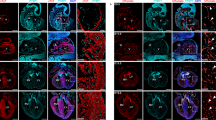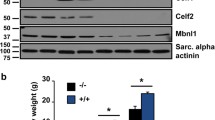Abstract
The heart is the first major organ to develop during embryogenesis and must receive proper spatiotemporal signaling for proper development. Failure of proper signaling between the first and second heart fields at twenty days gestation contributes to the generation of a congenital heart defect. The most common cyanotic congenital heart defect is tetralogy of Fallot (TOF) which requires surgical intervention in the first year of life. In right ventricular tissue of infants born with TOF, the levels of scaRNA1 are reduced and mRNA splicing is dysregulated. In this study, we investigate a method of quantifying pseudouridylation levels in relation to scaRNA1 levels in spliceosomal RNA U2 in three different groups of samples: right ventricular (RV) tissue of infants born with TOF versus RV tissue from normally developing infants, scaRNA1 knockdown in primary normal cardiomyocytes derived from normally developing infants, and scaRNA1 overexpression in primary cells derived from RV tissue from infants born with TOF. We hypothesize that the amount of pseudouridylation is dependent on scaRNA1 level, compromising spliceosomal function and therefore, contributing to the generation of a congenital heart defect. Our results revealed a statistically significant decrease of pseudouridylation levels in the right ventricular tissue of infants born with TOF compared to the controls. Knocking down the scaRNA1 levels in normal primary cardiomyocytes resulted in a statistically significant decrease of pseudouridylation. Finally, an overexpression of scaRNA1 in TOF primary cells resulted in an increase in pseudouridylation levels, but it did not achieve statistical significance. Our previous research provided an association between scaRNA levels, alternative splicing, and development. Here, we demonstrate that pseudouridylation levels in spliceosomal RNA U2 is dependent on the expression level of scaRNA1. Although further investigation is needed, we believe that scaRNA expression regulates biochemical modifications to spliceosomal RNAs, adjusting the fidelity of the spliceosome, allowing for controlled alternative splicing of mRNA that is important in embryonic development. If validated, this is an underappreciated mechanism that is critical for regulating proper embryonic development.





Similar content being viewed by others
References
Sun C, Kontaridis MI (2018) Physiology of cardiac development: from genetics to signaling to therapeutic strategies. Curr Opin Physiol 1:123–139
Carlson BM (2014) Human embryology and developmental biology, 5th edn. Elsevier Saunders, Philadelphia
Chong JJ, Forte E, Harvey RP (2014) Developmental origins and lineage descendants of endogenous adult cardiac progenitor cells. Stem Cell Res 13(3 Pt B):592–614
van der Linde D, Konings EE, Slager MA, Witsenburg M, Helbing WA, Takkenberg JJ et al (2011) Birth prevalence of congenital heart disease worldwide: a systematic review and meta-analysis. J Am Coll Cardiol 58(21):2241–2247
Fahed AC, Gelb BD, Seidman JG, Seidman CE (2013) Genetics of congenital heart disease: the glass half empty. Circ Res 112(4):707–720
O'Brien JE Jr, Kibiryeva N, Zhou XG, Marshall JA, Lofland GK, Artman M et al (2012) Noncoding RNA expression in myocardium from infants with tetralogy of Fallot. Circ Cardiovasc Genet 5(3):279–286
Cao T, Rajasingh S, Samanta S, Dawn B, Bittel DC, Rajasingh J (2018) Biology and clinical relevance of noncoding sno/scaRNAs. Trends Cardiovasc Med 28(2):81–90
Hoeppner MP, White S, Jeffares DC, Poole AM (2009) Evolutionarily stable association of intronic snoRNAs and microRNAs with their host genes. Genome Biol Evol 1:420–428
Adachi H, Yu YT (2014) Insight into the mechanisms and functions of spliceosomal snRNA pseudouridylation. World J Biol Chem 5(4):398–408
Patil P, Kibiryeva N, Uechi T, Marshall J, O'Brien JE Jr, Artman M et al (1852) (2015) scaRNAs regulate splicing and vertebrate heart development. Biochim Biophys Acta 8:1619–1629
Antonicka H, Choquet K, Lin ZY, Gingras AC, Kleinman CL, Shoubridge EA (2017) A pseudouridine synthase module is essential for mitochondrial protein synthesis and cell viability. EMBO Rep 18(1):28–38
Nachar N (2008) The Mann–Whitney U: a test for assessing whether two independent samples come from the same distribution. Tutor Quant Mehods Psychol 4(1):13–20
Milenovic ZM (2011) Application of Mann–Whitney U test in research of professional traning of primary school teachers. Metodicki obzori 6(1):73–79
Acknowledgements
We would like to thank Michael Filla for his assistance with laboratory procedures and Dr. Marissa Roffler for her statistical expertise.
Funding
This research was supported by Kansas City University of Medicine and Biosciences Intramural Grant.
Author information
Authors and Affiliations
Contributions
CN carried out the experiments and wrote the manuscript. NK designed and oversaw experimental procedures and reviewed the manuscript. JM & JO helped formulate experimental plan, interpret data, and review the manuscript. DB designed and oversaw experimental procedures in addition to review of the manuscript.
Corresponding author
Ethics declarations
Conflicts of interest
All authors have no conflicts of interest to declare.
Ethical Approval
All procedures performed in this study were in accordance with the ethical standards of the institutional and/or national research committee and with the 1964 Helsinki declaration and its later amendments or comparable ethical standards.
Informed Consent
Informed consent was obtained from a parent or legal guardian post review of consent document and after all questions were answered. Institutional review board approvals were obtained for this study (IRB # 11120627).
Additional information
Publisher's Note
Springer Nature remains neutral with regard to jurisdictional claims in published maps and institutional affiliations.
Electronic Supplementary Material
Below is the link to the electronic supplementary material.
Rights and permissions
About this article
Cite this article
Nagasawa, C.K., Kibiryeva, N., Marshall, J. et al. scaRNA1 Levels Alter Pseudouridylation in Spliceosomal RNA U2 Affecting Alternative mRNA Splicing and Embryonic Development. Pediatr Cardiol 41, 341–349 (2020). https://doi.org/10.1007/s00246-019-02263-4
Received:
Accepted:
Published:
Issue Date:
DOI: https://doi.org/10.1007/s00246-019-02263-4




